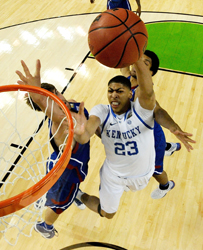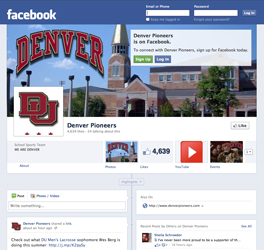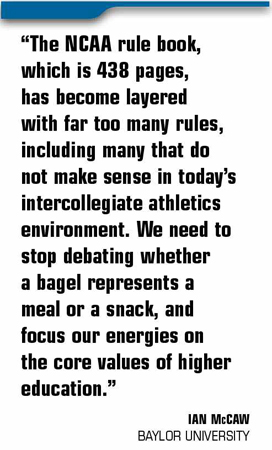■ What is one trend in college athletics you’d like to see stop?
Ian McCaw, Baylor University: A trend that I would like to see changed is the increasing responsibility placed upon athletics departments, and more specifically compliance offices, to monitor every aspect of NCAA rules. The NCAA rule book, which is 438 pages, has become layered with far too many rules, including many that do not make sense in today’s intercollegiate athletics environment. We need to stop debating whether a bagel represents a meal or a snack, and focus our energies on the core values of higher education. In a recent case involving the University of North Carolina, the NCAA placed an expectation on the institution that it should have monitored social media communication from its staff and student athletes. This standard seems unreasonable in today’s culture and puts all NCAA members at risk. With that, I applaud the efforts of the NCAA Rules Working Group that is focused on deregulation and developing rules that are sensible, enforceable and able to be monitored.
Richard Giannini, University of Southern Mississippi [Editor’s note: Giannini retired at the end of 2011]: It would be extremely helpful to the future of collegiate athletics if all the institutions and conferences in the various divisions of the NCAA look at what’s in the best interest of its division of universities. It seems the majority of the institutions only look out for themselves or their small conference entity and do not care about the whole. The professional organizational model, with the exception of playing for pay, does a much better job in making sure it works for all and is competitively balanced.
 |
ADs would like to see a rules change on “one and dones” in college basketball, when top players such as Kentucky’s Anthony Davis play only one season before going pro.
Photo by: Getty Images |
Mike O’Brien, University of Toledo: I would like to see the rule change on “one and dones” in college basketball. Football and baseball’s concept is much more designed to the educational piece of the student athlete. Leaving college after one year is not a good model to allow student athletes to be students during their time in college, while at the same time definitely limiting their progress toward the prospect of graduation.
Gene Taylor, North Dakota State University: I would like to see the trend of the one-and-done (or two-and-done) student athlete to stop. I realize this is primarily a men’s basketball issue and somewhat limited when you take into account all of the Division I men’s basketball programs and athletes compared to those that are leaving after one year. I feel the image of this hurts college athletics and has the perception of our programs being a training ground for professionals. Since it is only a few athletes that are done after a year or two, it seems like there would be a solution to this without affecting programs significantly. I think the sense with the general public is we have lost our mission as Division I athletic programs when they see schools lose athletes after only one or two years to pursue professional opportunities.
Peter Fields, Montana State University: The voice of the athletic director is becoming more and more silent, except during crisis situations. The expectation is that athletic directors oversee and manage perhaps the university’s most visible and highly scrutinized department, but whether it is in the NCAA manual, conference realignment, or hiring of a high-profile coach, external forces and pressures limit their role. When programs are running well, the AD voice is seldom heard, but when the bus starts hitting bumps in the road and all hell breaks loose with the media and public,
expectations are for immediate corrections and the AD is thrust into a far more public role.
Peg Bradley-Doppes, University of Denver: The fundamental purpose of collegiate athletics is to provide a unique forum for the intellectual, athletic and personal growth of student athletes. The well-being of these young men and women must always be our foremost priority. To this end, the NCAA and its member institutions have done an admirable job in using GSR (Graduation Success Rates) and APR (Academic Progress Rate) scores to encourage matriculation and academic achievement. Preparing student athletes for life beyond college and transitioning them into roles where they can use what they have learned as they launch their careers seem to be two inseparable objectives. I believe our collective progress in the former area has been significant. While there may not necessarily be a negative trend in the latter goal, I believe there are a growing number of opportunities for us to proactively move student athletes into successful careers after graduation. I hope that the coming years will witness measurable progress in this regard. If we make more concerted efforts to streamline young men and women into appropriate professions conducive to further growth and success, we can fulfill the mission of collegiate athletics in exciting new ways.
■ What is your favorite technology that’s having an impact in collegiate athletics?
McCaw: This is an exciting time for college athletics since technology allows athletic departments to develop and implement new ideas and concepts every day. We have focused most of our technology improvements on fan interaction and engagement, so that they feel like they’re part of the athletic department. Facebook, Twitter, Google+ (we did “hangouts” during NCAA basketball where select fans got to video chat with players and coaches) and Crowd Cameo (fans can send in photos that appear on the video board at games) are all interactive programs that utilize this. We have also developed a Baylor Bold Rewards program that gives prizes and rewards those fans that not only attend games, but those who are active in social media.
Giannini: Social media is completely changing the communications and media strategy of college athletics. A majority of social media is good; however, some of it is extremely harmful. Anonymous posters are not good for anyone. A law should be passed that you have to sign your name. This would stop totally incorrect rumors that run rampant on the social network outlets. Computers, the Internet, iPhones, iPads, Facebook, Twitter and other technology devices are becoming the quickest way of communication. Print media is at a real crossroads, with several outlets starting to reduce the number of days they publish. You better get up to speed with social media or your institution will be left behind.
O’Brien: Video streaming for all of our sports has become extremely beneficial on many different levels. There is no secret some sports receive more attention and publicity than others. However, for those that may not appear as often on the front page, this vehicle has assisted with recruiting and the overall promotion of all of our sports. We want to have a model of a total sports program at Toledo, and that includes doing all we can to ensure the student athletes have a superior overall experience while at Toledo.
 |
| Schools say that social media sites such as Facebook have enhanced their ability to communicate with constituents. |
Taylor: I really enjoy all of the technology that allows our fans instant access to our program and allows us to provide immediate updates and information to our fans. Technologies like Twitter, Facebook, YouTube, various mobile apps, etc., are all very exciting for our program. As we made our run to our national championship, these tools allowed us the ability to stay in contact with not only our local fan base, but our Bison fans across the country. It does keep our media relations staff busy by updating the information, but the ability to reach so many fans across the country, instantly in some cases, [enhances] our ability to promote our athletes and our programs to our supporters in more ways than the traditional media outlets. These tools also allow us to begin cultivating our younger fans who only use these tools for their sources of information.
Fields: Twitter is good and bad. When used correctly for information, it is a great tool (scores, bits of information, answering questions). When used incorrectly (posting inappropriate information), it is your worst nightmare.
Bradley-Doppes: The advent of social media has enhanced communication in ways few could have imagined a decade ago. Naturally, this budding societal phenomenon has had a significant impact on the world of collegiate athletics. Among the many ways social media has transformed the industry, I believe two results are of critical importance. First, these avenues provide new ways to disseminate the positive message of collegiate sports. Student athletes and coaches can be powerful role models with inspirational stories that can truly have an impact on society. The various platforms of social media provide dynamic and efficient means to communicate these positive messages for the benefit of others. Second, social media has yielded new possibilities to engage fans and various internal and external communities. There are now a number of robust ways to share the excitement of college athletics with people in forums that are entertaining and easily accessible. Additionally, these interactive tools have the capability to actually involve others. This is an extraordinary change from the traditional one-way communication of the past.






